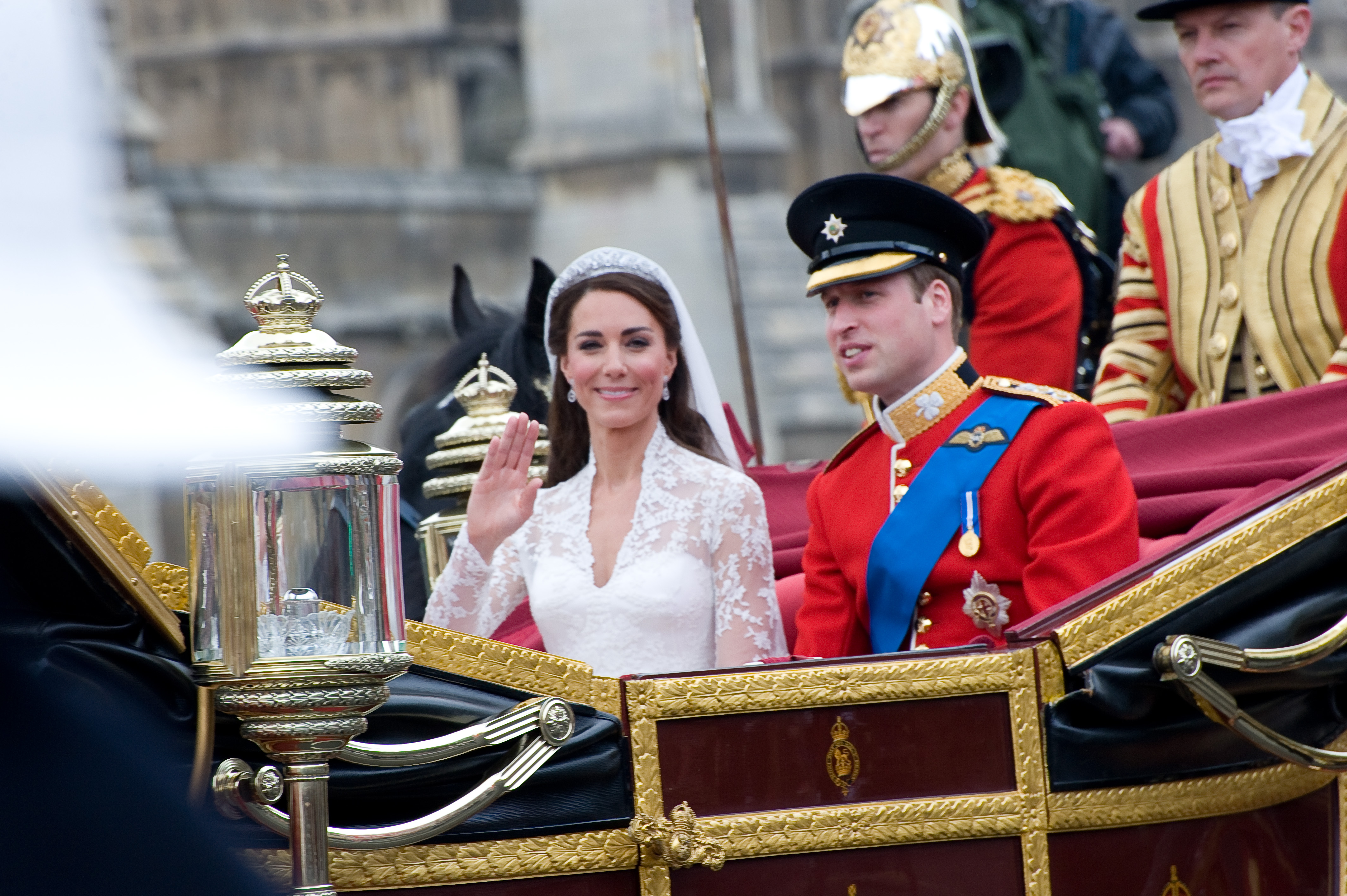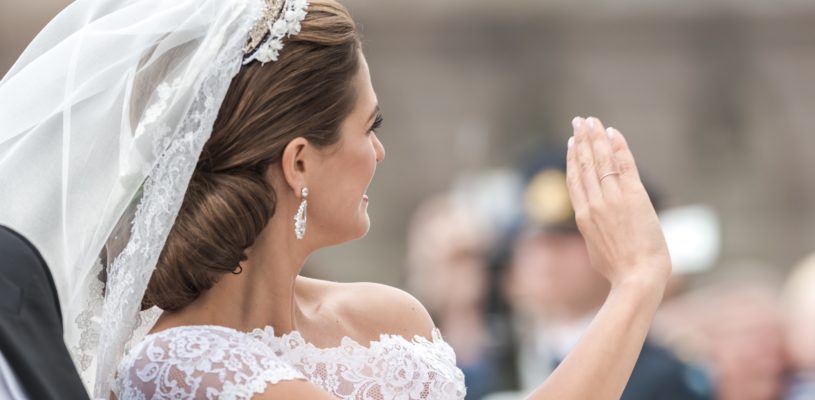”En riktig prinsessekjole” – Da tenker man på romantiske brudekjoler med store og fyldige skjørt. I virkeligheten har Europas prinsesser båret brudekjoler med mange forskjellige snitt og former, avhengig av tidens trender og brudens personlige stil.
I dette innlegget setter vi fokus på de mest ikoniske kongelige brudekjoler fra de siste 100 år. Her finner du alt fra overdådige kjoler med detaljer som sløyfer, pels og fleser til minimalistiske kjoler med smale silhuetter og myk silke.
Felles for kjolene, uansett stil og form, er at de er blitt brukt av stilfulle kvinner. Enten kongelige kvinner eller kvinner som har giftet sig inn i et av Europas tradisjonsrike monarkier.
Se de mest ikoniske kjolene i infografikken (klikk på bildet for en større utgave).
Ikke et hvilket som helst bryllup
Et kongelig bryllup er mere enn bare et bryllup. Det er en folkefest med enorm kulturell betydning. Et eksempel på dette er Diana og Charles bryllup i 1981. Bryllupet ble sett av mer enn en milliard mennesker på tv.
Når det blir vist kongelige brylluper følger flere millioner seere med. En evig snakkis er brudekjolen. Hvis en prinsesse bruker en bestemt type brudekjole er det garantert at den kommer til å inspirere mange andre brudekjoler.

Da Kate middleton – nå hertuginne Catherine af cambridge – ble gift med Prins William i 2011, utløste kjolen hennes mye snakk. Mange moteeksperter mente at med Sarah Burtons design markerte kjolen et trendskifte. Mens stroppløse kjoler hadde vært popluære i mange år, ble nå brudekjoler med lange ermer mere populære. Kjolens delikate blonder og vintage utseende ble også en stor inspirasjon for mange brudetrender.
Regler for kongelige bruder
Selv om variasjonen er stor innenfor kongelige brudekjoler og at det er plass til brudens personlige stil, er det likevel en etikette som skal overholdes. Det betyr at kjolen skal være ærbar og ikke vise for mye hud.
I nyere tid er reglene blitt mindre strenge og hos nåtidens bruder er det ganske normalt å se mere hud og formsydde kjoler. Likevel er skuldrene alltid tildekket (i alle fall i kirken) og man ser sjeldent kavalergang eller mye ben.
Her ser vi to generasjoner av det svenske kongehus: Dronning Silivia og Kronprinsesse Victoria. Silvia giftet seg i 1976 mens Victoria ble gift i 2010. Det er også enkelt å se at det har vært tidsforskjell i kjolene. Mens Silvias kjole har lange ermer og høy, rund utskjæring til halsen, viser Victorias kjole til gjengjeld mer hud med korte ermer og synlige kragebein. Begge kjoler overholder likevel de kongelige forskrifter om tekkelighet samtidig med at de viser en utvikling gjennom tiden.
Fem spesielle kjoler
Som man ser i infografikken vår har de seneste 100 årene budt på mange vakre og ikoniske kjoler. De har ofte vært med til å danne en trend i deres samtid og etterladt spor i historiebøkene. Her er et utvalg av fem kjoler som vi synes fortjener ekstra oppmerksomhet.
Grace Kelly
Grace Kellys kjole som ble skapt av Helen Rose fra MGM Studios i 1956 viser på klassisk vis at tidløs Hollywood eleganse aldri går av mote. Dette ble understreket i 2011 da Kate Middleton brukte en brudekjole med tydelige referanser til Kellys vakre kjole med blondeermer.
Diana
En kjole de færreste kommer til å glemme er Dianas dramatiske brudekjole. Kjolen ble laget av David & Elizabeth Emanuel I 1981. De store ermene, blondene og rysjene langs kraven og det nesten 8 meter langt slepet har gjort at kjolen bade blir elsket og hatet for sitt spesielle design. Med andre ord kan man si at den ikoniske kjolen skrev motehistorie.
Mette-Marit
Mette-Marits kjole fra 2001 ble skapt av Ove Harder Finseth. Kjolen skiller seg ut ved å være nyskapende i sin enkelhet. Siden bryllupet har Mette-Marit vist at hennes personlige stil er enkel og klassisk, noe brudekjolen hennes og viste. Brudekjolen klarte også å fremvise nordisk minimalisme på sitt beste.
Mary
Den danske Kronsprinsesse Mary, fortjener også en plass på denne listen. Hun imponerte millioner av seere da hun sa ja til Kronprins Frederik i 2004. Kjolen er enkel og overdådig på samme tid. Mary bar det samme brudesløret som Dronning Margrethe bar i sitt eget bryllup.
Kate
Kate Middletons fantastiske vakre kjole fra Sarah Burton/Alexander McQueen er den nyeste på listen, men fortjener likevel en plass som en ikonisk kjole. Vi tror kjolen hennes kommer til å holde seg i motebildet i mange år fremover. Den vakre og stilige kjolen har imponert oss og motekritikere over hele verden.
Fremtidens kongelige brudekjoler
Det er vanskelig å forutse hva utviklingen kommer til å være for de kongelige brudekjolene eller hvem som kommer til å bruke de. Kanskje den neste kongelige brudekjolen blir i det bristiske kongehuset når Prins Harry finner sin utkårne? Hvordan kommer fremtidens kongelige til å se ut når de går opp av altergangen? Bare tiden vil vise. Vi gleder oss til å følge med i utviklingen!



Philosophy is the discipline that studies major and universal questions, including existence, knowledge, values, reason, and language. It covers a vast number of topics and issues, from ethics and political figures to metaphysics and logic. Here are the main nuances of philosophy:
1. Definition of Philosophy
Philosophy comes from the Greek words “philos” (love) and “sophia” (wisdom). It is the desire to realize and make sense of the world around us and our place in it.
2. The Main branches of philosophy
– Ontology research of the essence of being and existence.
– Epistemology the study of the nature and limits of cognition.
– Ethics the analysis of ethical principles and concepts of good and evil.
– Logic research of the forms and principles of correct thinking.
– Political philosophy the study of questions of power, justice and the state.
3. Famous Philosophers
In the course of the history of philosophy, many thinkers have made meaningful contributions to this science. Some of the most famous include:
– Socrates, considered the founder of Western philosophy.
– Plato, a student of Socrates, developed the doctrine of forms.
– Aristotle, the creator of logic and many of scientific fields.
– Immanuel Kant, known for his [url=https://thephilosopher.net/]Philosophy[/url] critical philosophy and work on moral issues.
4. The Relevance of Philosophy in the Modern World
Philosophy remains relevant in the modern world as it helps people to understand difficult social and moral issues, also develops critical thinking. It influences the legal system, politicians, and different fields of science.
5. Practical Applications of Philosophy
Philosophical ideas enter everyday life. Ethical reflection helps people do the right thing in complex situations, and philosophical analysis contributes to greatest understanding of problems related to technology, art, and social justice.
Philosophy is not only an academic discipline, as well as method of thinking that helps us to understand life’s complexities and make informed choices.
Philosophy is the discipline that studies major and universal questions, such as existence, knowledge, values, mind, and language. It encompasses a vast number of subjects and problems, ranging from ethics and political figures to metaphysics and logic. Here are the main aspects of philosophy:
1. Definition of Philosophy
Philosophy comes from the Greek words “philos” (love) and “sophia” (wisdom). It is the desire to understand and make sense of the world around us and our place in it.
2. The Main branches of philosophy
– Ontology research of the essence of being and existence.
– Epistemology the study of the nature and limits of cognition.
– Ethics the analysis of moral principles and concepts of good deed and evil.
– Logic research of the forms and principles of correct thinking.
– Socio-political philosophy the study of questions of power, justice and the state.
3. Eminent Philosophers
During the history of philosophy, many thinkers have made meaningful contributions to this science. Some of the most famous include:
– Socrates, considered the founder of Western philosophy.
– Plato, a student of Socrates, developed the doctrine of forms.
– Aristotle, the creator of logic and a large number of scientific fields.
– Immanuel Kant, known for his own [url=https://thephilosopher.net/prust/]Marcel Proust[/url] critical philosophy and work on moral issues.
4. The Relevance of Philosophy in the Modern World
Philosophy remains urgent in the modern world as it helps people to understand complex social and ethical issues, and also develops critical thinking. It affects the legal system, politicians, and different fields of science.
5. Practical Applications of Philosophy
Philosophical ideas enter daily life. Ethical reflection helps people do the correct thing in difficult situations, and philosophical analysis contributes to greatest understanding of problems related to technology, art, and social justice.
Philosophy is including an academic discipline, but also method of thinking assists us to understand life’s complexities and make informed choices.
Philosophy is the discipline that studies fundamental and universal questions, including existence, knowledge, values, mind, and language. It covers many subjects and problems, ranging from ethics and political figures to metaphysics and logic. Here are the main aspects of philosophy:
1. Definition of Philosophy
Philosophy comes from the Greek words “philos” (love) and “sophia” (wisdom). It is zeal to realize and make sense of the world around us and our place in it.
2. The Main branches of philosophy
– Ontology research of the essence of being and existence.
– Epistemology the study of the nature and limits of knowledge.
– Ethics the analysis of moral principles and concepts of good and evil.
– Logic the study of the forms and principles of correct thinking.
– Political philosophy the study of questions of power, justice and the state.
3. Famous Philosophers
Throughout the history of philosophy, almost many thinkers have made weighty contributions to this science. Some of the most famous include:
– Socrates, considered the progenitor of Western philosophy.
– Plato, a student of Socrates, developed the doctrine of forms.
– Aristotle, the creator of logic and a large number of scientific fields.
– Immanuel Kant, known for his [url=https://thephilosopher.net/ficdzherald/]Scott Fitzgerald[/url] critical philosophy and work on moral issues.
4. The Relevance of Philosophy in the Modern World
Philosophy remains relevant in the modern world because enables people to understand difficult social and moral issues, and also develops critical thinking. It affects the legal system, politicians, and different fields of science.
5. Practical Applications of Philosophy
Philosophical ideas penetrate everyday life. Ethical reflection helps people do the right thing in difficult situations, and philosophical analysis contributes to best understanding of problems related to technology, art, and social justice.
Philosophy is not only an academic discipline, yes and method of thinking that helps us to understand life’s complexities and make informed choices.